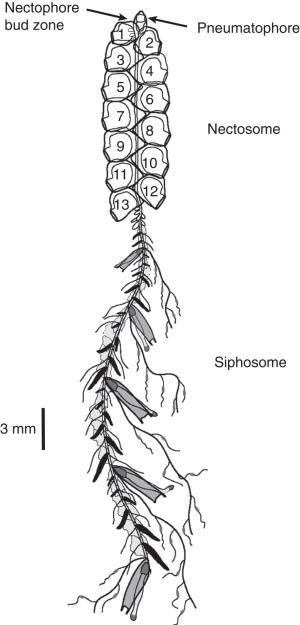Siphonophore colonies swim by coordinating members' water jets
Siphonophore colonies swim by coordinating members' water jets
Colonies of Siphonophores, a group of chain-like hydrozoan predators, coordinate members' water jets to optimise propulsion and steering.
Nanomia bijuga is part of a group of organisms, known as physonect siphonophores, a group of chain-like hydrozoan predators and a relative of jellies, anemones and corals.
This siphonophore navigates the ocean in colonies measuring about 12 inches (30 centimeters) long. Each section within a colony is a specialized group of genetically identical individuals that perform different jobs.
The jet-producing members of the physonect colony, called nectophores, are genetically identical clones arranged in a propulsive unit called a nectosome which acts as an engine for whole colony.

Rare coordination
Each nectophore sphere produces a propulsion jet, much like its larger jellyfish cousins. But unlike single-jet jellyfish, a colony can have as many as a dozen jets propelling it wherever it wants to go.
When nectophores are small, they cannot produce much thrust, so they use their jets to turn the entire colony, found the researchers. This action of nectophores makes the colony to redirect itself very quickly. Working together, they form a living propulsion unit that is rare in animals.
The study also found that a nectophore's age and size determined its role in the colony's propulsion. New buds emerge at the colony's tip, nudging older and larger nectophores down toward the tentacles.
The bigger the nectophore, the longer and more powerful its thrust, so the biggest individuals at the end of the cluster produced the strongest jets, driving the colony's forward momentum.
Meanwhile, the younger, smaller nectophores controlled the steering. Frequent pulses from their weak jets kept the colony on course.
- Log in to post comments




























